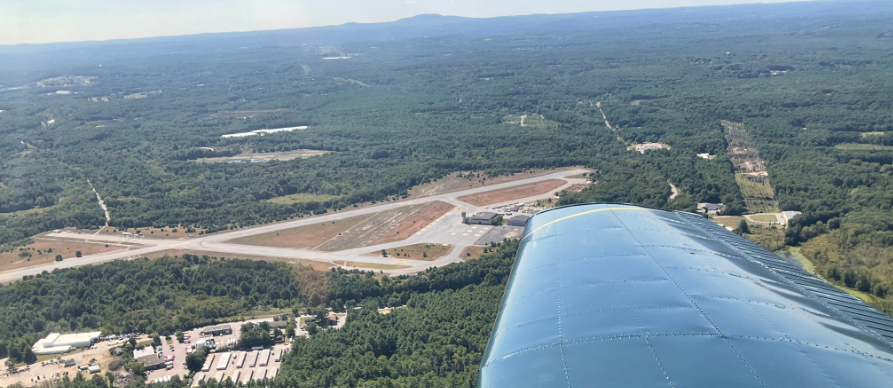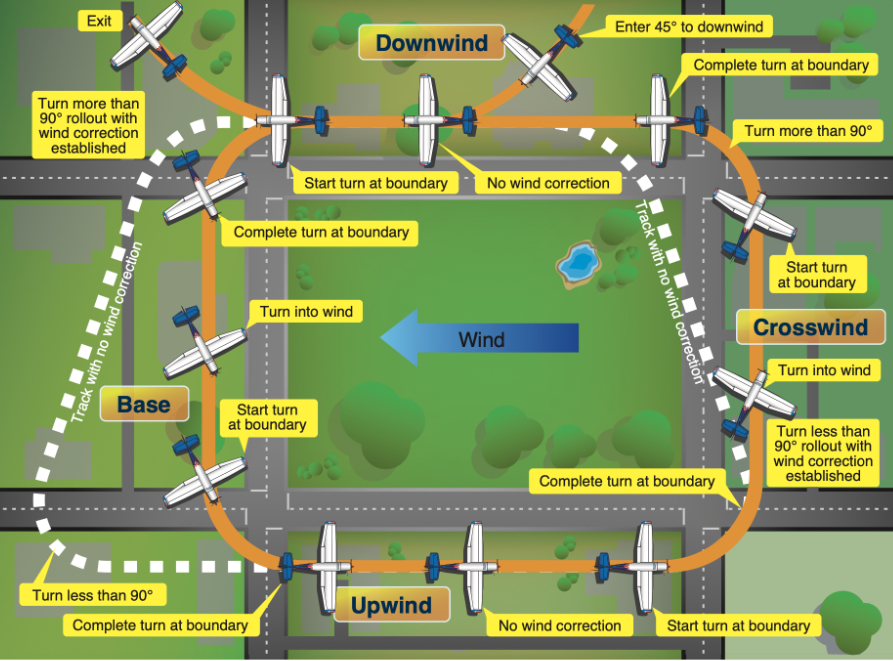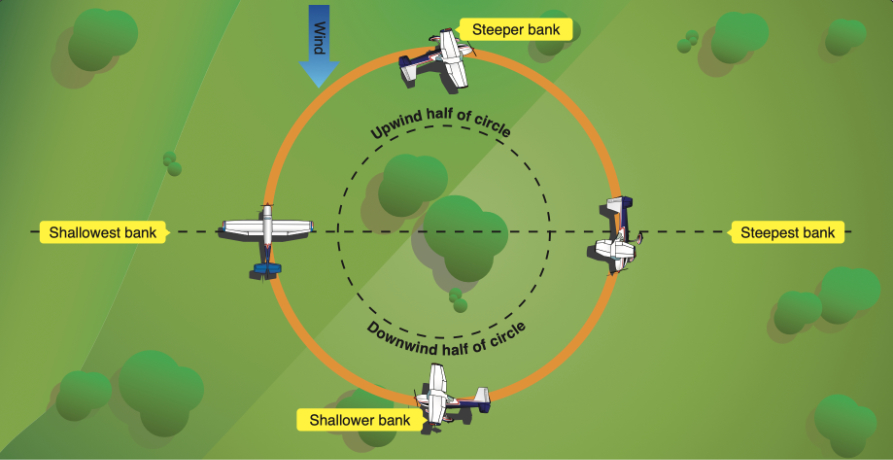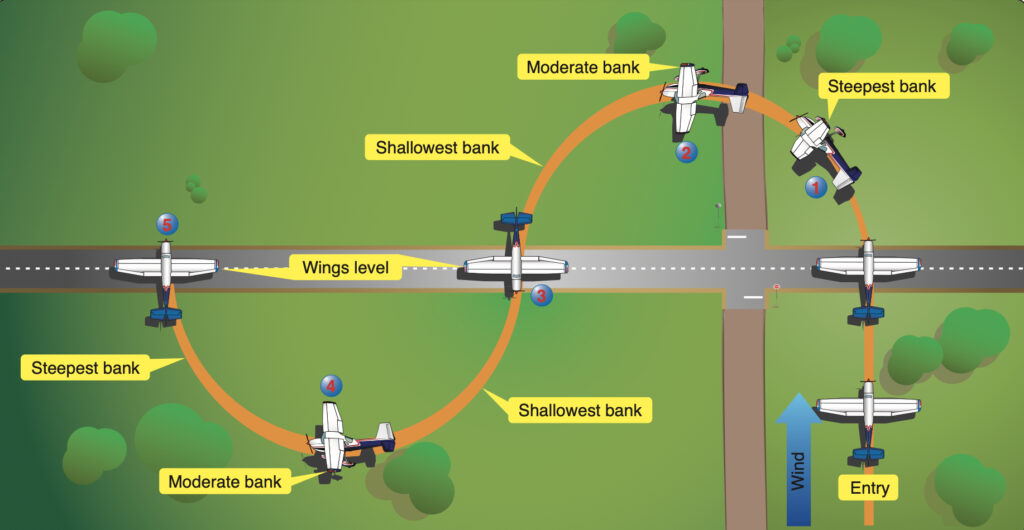
The Purpose of Ground Reference Maneuvers
Ground reference maneuvers and their related factors are used in developing a high degree of pilot skill. The elements and principles involved are applicable to performance of customary pilot operations.
They aid in the pilot analyzing the effect of wind and other forces acting on the airplane and in developing a fine control touch, coordination, and the division of attention necessary for accurate and safe maneuvering of the aircraft
Rectangular Course (Traffic Pattern)
- Maintaining a specific relationship between the airplane and the ground.
- Dividing attention between the flightpath, ground-based references, manipulating the flight controls, and scanning for outside hazards and instrument indications.
- Adjusting the bank angle during turns to correct for groundspeed changes to maintain constant radius turns.
- Rolling out from a turn with the required wind correction angle to compensate for any drift cause by the wind.
- Establishing and correcting the wind correction angle to maintain the track over the ground.
- Preparing the pilot for the airport traffic pattern and subsequent landing pattern practice.

Turns Around a Point
- Maintaining a specific relationship between the airplane and the ground.
- Dividing attention between the flightpath, ground-based references, manipulating of the flight controls, and scanning for outside hazards and instrument indications.
- Adjusting the bank angle during turns to correct for groundspeed changes in order to maintain a constant radius turn, steeper bank angles for higher ground speeds, shallow bank angles for slower groundspeeds.
- Improving competency in managing the quickly changing bank angles.
- Establishing and adjusting the wind correction angle to maintain the track over the ground.
- Developing the ability to compensate for drift in quickly changing orientations.
- Developing further awareness that the radius of a turn is correlated to the bank angle.

S-Turns Across a Road
- Maintaining a specific relationship between the airplane and the ground.
- Dividing attention between the flightpath, ground-based references, manipulating the flight controls, and scanning for outside hazards and instrument indications.
- Adjusting the bank angle during turns to correct for groundspeed changes to maintain a constant radius turn—steeper bank angles for higher ground speeds, shallow bank angles for slower groundspeeds.
- Rolling out from a turn with the required wind correction angle to compensate for any drift cause by the wind.
- Establishing and correcting the wind correction angle to maintain the track over the ground.
- Developing the ability to compensate for drift in quickly changing orientations.
- Arriving at specific points on required headings.

Effects of Wind on Ground Track and relation to a Ground Reference Point
Wind Correction
- Whenever there is any crosswind, the plane will have to be crabbed into the wind to maintain a straight track across the ground or a given distance around a point
- The amount of crab varies with the strength of the wind and should be adjusted based on visual cues
- During a turn, the amount of bank will vary depending on groundspeed to maintain a constant radius around a point
- The faster the groundspeed (tailwind), the steeper the bank required to maintain ground track
- The slower the groundspeed (headwind), the shallower the bank required to maintain ground track
- During turns, to maintain altitude, increase back pressure as necessary
- Use visual references and the instrument indications
Effects of Bank Angle and Groundspeed on Rate and Radius of Turn
Rate of Turn
- The rate of turn is the number of degrees per second the aircraft is turning. Of course, the higher the degrees per second the higher the rate of turn and vice versa
- Rate of turn is affected by both the bank angle and groundspeed
- As bank angle increases, so does the rate of turn
- As groundspeed increases, the rate of turn decreases
- Therefore, the higher the bank angle and the slower the groundspeed, the higher the rate of turn
Radius of Turn
- The radius of a turn describes the size of circle an aircraft would fly during a turn
- The radius is a measurement taken from the center of the circle to any point on the circle
- Radius of turn is also affected by both the bank angle and groundspeed
- As bank angle increases, the radius of turn decreases
- As groundspeed increases, the radius of turn increases
- Therefore, the higher the bank angle and the slower the groundspeed, the smaller the radius of turn
The Relationship of the Rectangular Course to the Traffic Pattern
- The rectangular course is designed to be similar to a traffic pattern
- The aircraft should be flown parallel to and at a uniform distance, about ¼ to ½ mile, from the boundaries
- Not directly above the boundaries since this will not provide useable reference points for turning
- The pilot should be able to see the edges of the rectangle easily
- All turns should be started when the aircraft is abeam the corner of the field boundaries
- The closer your track is to the boundaries, the steeper the bank necessary at the turning points
- Bank should be limited to 45° maximum
- Basically, the rectangular course is a representation of the traffic pattern. It includes a downwind, base, upwind and crosswind leg. The pilot flies these legs to learn to adjust for changing wind conditions on the different legs, exactly like they would in the pattern